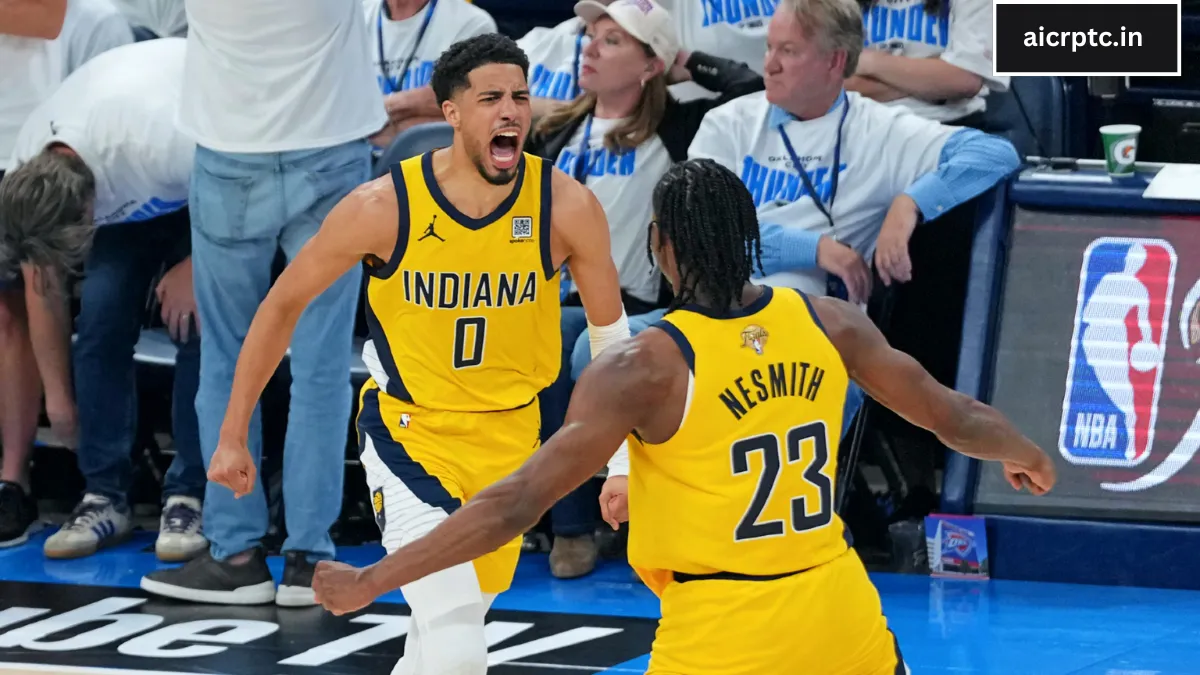OKLAHOMA CITY – Tipoff to the opener of the 2025 NBA Finals came a few minutes after 8:30 p.m. ET. A ferocious crowd at Paycom Center stood and roared, and their team of choice, the Oklahoma City Thunder, seized the court, primed to chase down the first league championship since the franchise came to town in 2008.
The Indiana Pacers joined the fray about an hour later.
Throughout the first half, the Pacers appeared tense, which translated into playing too quickly, overlooking key parts of their game plan, and, most critically, turning the ball over at an unprecedented rate.
To put this into perspective: Since the start of the play-by-play era in 1997, no team in a Finals game, in either half, has ever recorded 19 turnovers — until the Pacers did it in Game 1 on Thursday night.
This was the opposite of what they had intended to do against the Thunder’s aggressive, disruptive defense. It seemed poised to doom them for the final 24 minutes. Yet, somehow, they escaped this self-imposed trap with a trademark game-winning shot from guard Tyrese Haliburton.
The moment
Behind closed doors, in a visitors’ locker room that could have unraveled, the Pacers gathered their composure and checked their emotions. If they had glanced in the mirror beneath the roaring crowd, they would have seen a strange, unfamiliar reflection staring back.
Their shooting was not terrible, and the deficit on the scoreboard was manageable: OKC led 57-45. The Pacers had only made five fewer baskets than the Thunder by halftime but had lost possession far too often, resulting in 19 fewer shot attempts.
Throughout the season, the Eastern Conference champions had taken pride in their ball security. Averaging just 13.2 turnovers per game in the regular season — better than all but two teams — they even lowered that average to 12.7 during their playoff run against Milwaukee, Cleveland, and New York.
Remarkably, despite the turnovers, the Thunder converted just nine points directly off those mistakes. Still, this was hardly a winning formula — more a disaster waiting to happen.
“We like controlled chaos,” said Haliburton, “but that was just chaos. Ugly.”
Something needed to shift.
The impact
Saying “take better care of the ball” at halftime might sound obvious, but it’s hardly a practical solution. What does that even mean in the heat of an NBA Finals, against one of the league’s most relentless defenses, firing on all cylinders off stolen possessions?
“We just knew we had to value the ball a lot more,” center Myles Turner explained, adding specifics. “We started putting two hands, two eyes on the ball. Whoever was passing kept it high. It was all the basic fundamentals. Sometimes, that’s what it comes down to — going back to the basics. Chin on the ball, stuff like that.”
Four different Pacers had at least three turnovers in the first half. In the second half, none did. The team gave up just five turnovers, and the Thunder managed only two points off those errors.
Instead, Indiana outscored the favored home team 66-53 after halftime, including a 35-25 advantage in the fourth quarter. The Pacers’ offense found its rhythm: 51% shooting in the second half, 10-for-20 on three-pointers, and averaging 1.4 points per possession. All five starters and key reserve Obi Toppin — who had struggled early on — posted strong plus-minus ratings in the final two quarters.
The game featured just one lead change — at the critical moment. Without the Pacers calming their play, improving their passing, and anticipating OKC’s aggressive ball-hawking style, Haliburton’s clutch finish wouldn’t have been possible.
What they’re saying
“The turnovers were the first thing we talked about,” Pacers coach Rick Carlisle said. “We thought we were doing well on the boards, but they had 20 more shots than we did in the first half. That was fool’s gold. We just hit the reset button. We went whistle-to-whistle in the third, chipped away, and stayed in it.”
“You said it — we knew what kind of team this was,” Turner added. “At this level, you don’t have time to be shocked or disappointed. Probably historically bad, but we weathered it.”
Thunder coach Mark Daigneault on the Pacers’ adjustment in the third: “I thought they loosened up. They took better care of the ball. But our conversion on turnovers in the first half hurt us. We didn’t get the usual spark from those steals.”
Indiana’s Pascal Siakam reflected, “It’s just not who we are, but credit to their defense — they’re on another level disrupting the game and forcing mistakes.”
What’s next
Fixing things on the fly worked for Indiana on Thursday, but they’ll spend the coming days reviewing film before Sunday’s Game 2 (8 p.m. ET, ABC). They can’t afford to waste this lesson against the Thunder’s stifling defense.
For Oklahoma City, it’s one thing to pressure an opponent into 25 turnovers, but another to score just 11 points off those chances. That’s the “juice” Daigneault mentioned — the payoff from relentless defense. After all, what’s the fun in a make-or-miss grind if it doesn’t deliver results?
